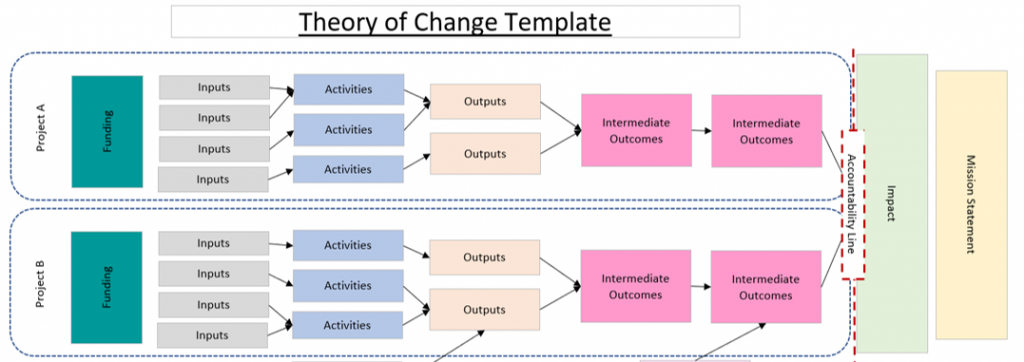Introduction
When it comes to describing and understanding how your organisation or project is going to create the change it wants to see in the world, there can be so many approaches to take it can be difficult to know which one is right.
From Theories of Change, Logic Models, Log Frames and more, it can be hard to understand the differences between them and choose which one is best.
In this article, we are going to explore the similarities and differences between a Theory of Change and a Logic Model. We will then go through some questions you can ask yourself to help decide which approach is best for you and your organisation.
What is a Theory of Change?
A Theory of Change is best described as a flow chart, diagram or description of why the activities you take part in will create the change you want to see in the world. It seeks to identify the resources that you will need, the main activities you will need to perform and, finally, the end products or services (outputs) which you will need to deliver. Crucially, it then identifies all of the step changes (outcomes) which will need to occur in order to deliver your long-term goal or mission.
Ready to create a Theory of Change within your own organisation?
Find out more about our online and blended learning training options below.
What does a Theory of Change look like?
Below is a typical Theory of Change template. To understand more about the elements you may find it useful to read the article here where we talk about a Theory of Change in more detail. The Theory of Change template can look intimidating at first glance, as it has a number of elements to it. At the same time, it becomes reassuringly intuitive and straight forward once the step-by-step guidelines are followed.

What is a logic model?
A logic model is a table or diagram that shows how your project or programme will work to fulfill an identified need. Similar to a Theory of Change it seeks to identify the resources you will need, the main activities you will need to take part in and, finally, the end result you are intending to achieve.
What does a logic model look like?
A logic model might be in a table as shown below or in a flowchart style. As you can see, both the Theory of Change and the logic model contain many of the same elements. For further information on the definitions of each of the main elements you may find it useful to visit our Theory of Change page.

Similarities
- As you can tell from the definitions and diagrams above, there is significant overlap between a Theory of Change and a Logic Model.
- They can fulfill many of the same purposes and create some of the same benefits for your team and organisation (although since a Theory of Change goes to further depth and nuance, than a logic model, this can often provide additional benefits which a logic model does not.
- Both a Theory of Change and a Logic Model work to identify inputs, activities, enablers, intermediate outcomes and impacts. In other words, putting name to and acknowledging all of the steps it will take to deliver the results you want.
- In both, there is a drive to identify not only what you are doing but what you are trying to achieve (outcomes and impact). This is in contrast to some approaches to managing a project which would track what you are doing and what you are delivering but would not work to identify if this had in turn created your ultimate goal.
- As a result of this approach, a Theory of Change and a Logic Model can lead to a robust approach to programme theory, monitoring and evaluation. If you can identify the main elements you need to have in place, to create the change you want to see in the world, you are able to measure, track and quantify if you have been successful.
Differences
- One of the primary differences between the two is that a Logic Model describes what you expect to happen but does not address why it will happen. The purpose of a Theory of Change is that it works to identify why your activities and interventions will create the outcomes it will. A Logic Model on the other hand will state what outcomes you expect to occur but not necessarily, why you expect that to happen.
- As a result of this difference, we can see that a Theory of Change makes much bigger strides in trying to establish the underlying causes of change, and supports us in making explicit what we believe to be the causal pathways.
- A Theory of Change works to understand the context in which a programme operates. It recognises that factors outside of the programme will often have an influence on the end result. A Logic Model, on the other hand, focuses much more on the programme itself and how it is operating rather than external factors.
- A logic model is often created after the programme has been developed, working forward from resources through activities to the end result. A Theory of Change is best created before an intervention starts, mapping backward from the end result in mind to identify the most appropriate intervention.
Theory of Change vs Logic Model - which one should we use?
So now that we have explored some of the similarities and differences between a Logic Model and a Theory of Change how do you choose which one to use?
Some considerations you might want to think about are:
- Time and Resource: A Theory of Change due to its additional complexity often requires more time and resource to get it established.
- Nature of the intervention: A Theory of Change is designed to capture the complexities of relationships. If you are operating in an environment where there a lot of factors (both internal and external) to creating the change you would like to see, a Theory of Change might be more appropriate. A more straightforward intervention might lend itself to a Logic Model.
- Stage of development: A Theory of Change works best when it is developed before the intervention has been put in place or when its in its early stages of development. Due to the process of backward mapping, identifying the end result you want first and then moving back from there, a Theory of Change works best if you can use it to identify and sculpt the intervention and your activities. Whilst you can certainly develop one later, it is important to be open to changing the intervention if your Theory of Change suggests this to be the case. A Logic Model on the other hand doesn’t help you identify the types of interventions or programmes to run, as they don’t help your team understand why a change will occur. Logic Models are therefore better when you have already designed your intervention.
- Importance of the intervention: A Theory of Change helps generate and capture a depth of understanding which isn’t present in a logic model. It is, therefore, well worth the time to develop one for interventions or programmes which are of great importance to your organisation. For those which are perhaps small projects which aren’t expected to last long a Logic Model can be preferable because you can get some of the benefits without using as much time or resource.
Summary
A Theory of Change and a Logic Model are in many ways very similar. They both function as a way to map out the resources you need, the main activities you take part in, what you will deliver as well as the end results you are trying to achieve (outcomes and impact).
Where they differ is that primarily a Theory of Change works to explain why a change will occur as opposed to simply what will occur. As a result, they are often more complex and need to account for the context of the intervention, as well as the influence of factors outside of the intervention.
Which one is appropriate will depend on the importance of your intervention, how complex the scenario is, when you are developing one and the time, resources and the skills you have available to you.
Thank you for taking the time to read this article and we hope that it has been useful to you today. At Analytics in Action Ltd we value keeping the conversation going and so we would like to take the opportunity to invite you to get in touch with us here, if you have any questions or feedback you would like to share.
Online Training and Webinars
Like this? Read more
5 unique challenges when creating a Theory of Change
The benefits of using a Theory of Change facilitator
Why a Theory of Change can be the start of being a Data Driven organisation



13 thoughts on “Theory of Change vs Logic Model”
This is a very nice and educative piece of publication, worth reading , thanks.
Thanks for the feedback Peter. Please feel free to have a look at some of the other articles we have available. If there is one you would be interested in seeing but isn’t available, please suggest it and we will do our best to make it happen!
Great!! I’m glad I came across this article today. Very insightful and well articulated. Thanks so much.
A simple and informative piece of work. Thank you.
Concise and precise piece of information on the subject, I was looking for.
Thanks its so interesting and informative piece of writing.
Thank you. We are glad you are enjoying the content and that you found it informative.
Best Wishes,
The AiA Team
Super helpful!
Thanks for the comment! We are pleased you have found the content helpful and we hope you enjoy some of the other content and training we have on our website as well.
Best wishes,
The AiA Team
How does a ToC determine how change will occur? It is entirely prospective. It needs a ‘change’ monitor or exploration (PDCA loop/CPD loop – John Seddon) to keep understanding what is happening and to steer it. It also seems to skip a ‘get to know’ stage. What is happening now and why does it not produce the required results. Surely ‘study the system’ is the first step?
Hi David,
Thanks for your comment and thoughts on the subject. As you mentioned, ‘studying the system’ when you look to create your Theory of Change, and having a way to update it and refine it, are both really important elements in creating a valuable Theory of Change. We spend a fair amount of time on both of these elements within our TOC facilitator training, if it is something you are interested in. It is also one of the reasons why measuring your impact is so important – so that you can develop an evidence base, which can be used to refine the interventions you create as well as the Theory of Change to go along with it.
We hope you enjoy spending the time learning more about this topic and how it may fit with your organisation.
Best wishes,
The AiA Team
Name :Gesit Izzulhaq
Website : https://uhamka.ac.id/
Email anda :gesitizzulhaq@uhamka.ac.id
Comment:Thank you for nice information